Blood transfusion is one of the emergency care for the saving of life of animal in case of severe medical emergency conditions. It was first done by Richard Lower in 1665 in dog. Now for the conditions like severe anaemia by various etiological factors, hypovolumic shock and automobile accidents making more need of blood transfusion in animals. The main objective of blood transfusion is to improve the oxygen carrying capacity of the blood and improvement of nutrients transport in the body.Day by day animals getting more importance due to high production in terms of milk,calf production especially in indigenous breeds like Deoni,Khillar and drought work from bullocks creating owner awareness and expectations making new horizon in blood transfusion in bovines.In bovines total 11 blood groups are present namely A,B,C,F,J,L,M,R,S,T and Z.Out of these B and J are clinically important for transfusition.
Indications of blood transfusion in Bovines
- In hemo-protozoal infections like Babesiosis, Thileriosis, Anaplasmosis etc.
- In Bacterial infections like Leptospirosis, Bacillary Haemoglobinuria etc.
- In recent surgical interventions like C-section, Dehorning etc
- In hepatic pathology like jaundice, abscess etc.
- In severe external parasitic infestation like lice, tick, flea etc.
- In severe internal parasitic infestations like Haemanchosis infestation, Oesophagostomiasis infestation etc
- In production diseases like Post parturient hemoglobinuria, nutritional deficiency anaemia caused by deficiency of iron, copper, folic acid and Vitamin B12 etc
In above all conditions there will be fall in RBC level in circulation from normal 5-8 Million/mm3 to below 3 Million/mm3 and Hb from normal 9-12 g/dl to below 4 g/dl.Fresh whole blood advised in cattle and 2-3ml/kg BW raises the PCV by 1%.
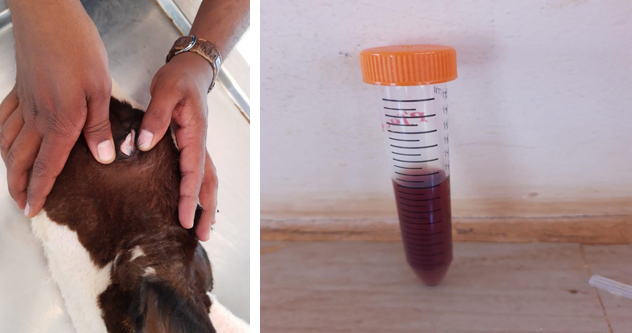
Selection of donors
- It should not be too young or too old; ideally age should be between 2 years to 8 years.
- It should be free from all type of infectious diseases should not be debilitated or undernourished.
- It should be apparently healthy.
- It should not have history of undergoing of major surgery, liver pathology recently.
- It should not have internal or external parasitic infestation.
- It should be having total RBC count above 5 million/mm3 and Hb above 6 g/dl.
- It should be of same breed as of recipient.
- For calf as recipient dam will be ideal donor likewise animals in the same herd with half sibs or full sibs will be ideal donors.
- Bovines can donate 8-14ml of blood per kg body weight.
Methods of blood transfusion
- Direct method: Here blood transfusion appartus connected to both donar and receipent. So from dinar directly blood will transfused to receipent.The main disadvantage of this method is the quantity of blood transfused will not be measured.
- Indirect method: Here blood from donar will be collected in the blood collection bag with anticoagulant in it.Then the measured quantity of blood will be transfused to receipent.
Matching for blood compatibility from donor to recipient, As follows
- Major matching: Here recipient plasma/serum mixed with donors RBC mix on a slide and observe under microscope…Clumping/haemolysis indicates incompatibility not go for transfusion…No clumping indicates you can go for transfusion.
- Minor matching: Here donor plasma/serum mixed with recipients RBC mix on a slide and observe under microscope.. Clumping/haemolysis indicates incompatibility not go for transfusion…No clumping indicates you can go for transfusion.
Instruments needed for blood transfusion under field conditions
Empty blood bag, transfusion drip set, blood collection vials plain and with EDTA for blood examination. In case of blood bag unavailability new, non-used, sterile empty urine bags, sterile empty glass bottles of capacity of 500ml and above can be used, and add 100ml of sodium citrate(3.8%) for every 350ml of blood and sodium citrate(3.8%) solution should be prepared early as per the need, sterile swabs,gloves,Thermometer.
Blood transfusion procedure
- Calculate the amount of blood needed for the recipient as per body weight and anaemic conditions, the total blood volume estimated in cattle is 10-20 ml/kg BW.So if the body weight of recipient is 30 kgs means blood to be given is 300-600 ml as per severity of the recipient.
- Prepare anticoagulant solution n blood collection bag/bottles.
- Check donor for health status and check compatibilities
- After confirming the compatibility, collect blood from donor from jugular vein under aseptic condition and after collection mix thoroughly with anti-coagulant in the collection bag/bottle. Collected blood should be transfused within 2 hours.It should not delayed; delaying causes haemolysis of RBC will not serve the purpose.
- After collection of blood immediately it should be transfused to recipients slowly drop by drop through the transfusion drip set with aseptic techniques, rapid administration should be avoided and recipients should be monitored carefully.
- Generally blood should be given intravenously at the rate not exceeding 10ml/kg/hour.
- Calculated dose of anti-histaminic and steroids injected to recipients to avoid the unusual reactions.Adrenaline, steroids and anti-histaminic should be kept ready for emergency condition.
- After transfusion watch the animal for hyper sensitivity, allergic reaction, delayed hypersensitivity and pyrexia.
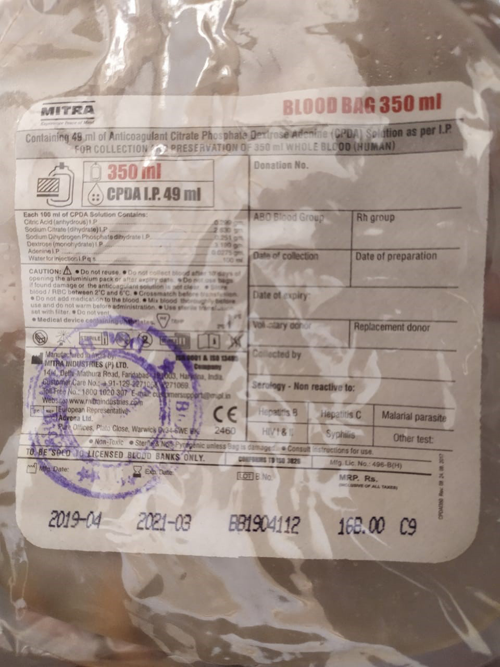
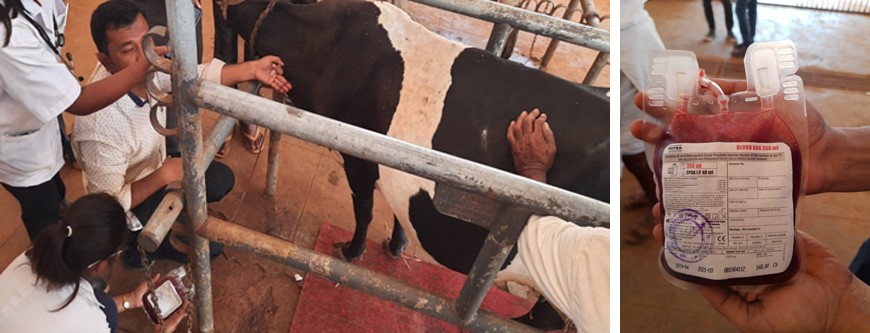
Advantages of blood transfusion
- Its important tool in case of emergency conditions like hypovolumic shock mediated by trauma or blood loss due to accidents.
- For successful therapy of diseases like Thileriosis, Babesiosis etc
- For supporting of healing in case of major surgical procedures as a post operative care measure.
- As a supportive treatment in heavy internal and/or external parasitic infestation.
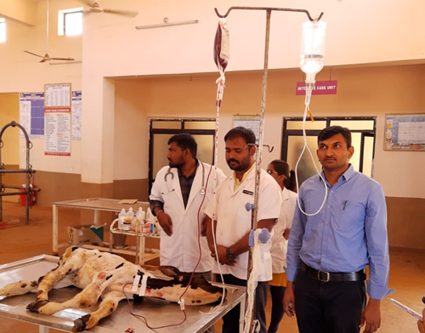
Adverse reactions observed in bovines after transfusion
- Immediatly during transfusion there may be sudden shivering, allergy and histamine mediated hypersensitivity observed rarely.
- Shivering, dyspnoea, sweating may be observed.
- Immune mediated hematuria.
- Hypocalcimia due to citrate toxicity.
- Transfer of sub clinical infections like Thileriosis, Brucellosis, Tuberculosis etc.
- Delayed hypersensitivity reaction.
Disadvantages of blood transfusion
- Chance of hypersensitivity.
- Chances of transmission of diseases especially subclinical haemoprotozoan diseases.
- Urticaria, pyrexia occasionally.
- Predisposes for auto immune complications.
- Mismatch/cross reaction leads to collapse and death of animal.
References
- Text book of Clinical Veterinary Medicine. By ICAR Publication 2009
- Essentials of Veterinary Surgery by Venugopala 8 th Edition.
|
The content of the articles are accurate and true to the best of the author’s knowledge. It is not meant to substitute for diagnosis, prognosis, treatment, prescription, or formal and individualized advice from a veterinary medical professional. Animals exhibiting signs and symptoms of distress should be seen by a veterinarian immediately. |


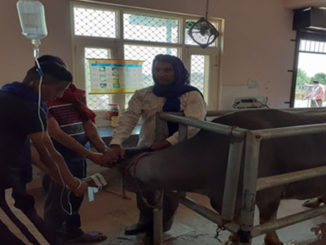
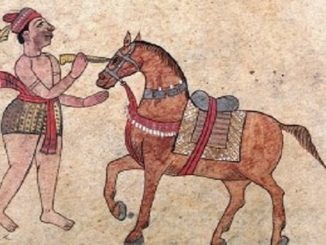
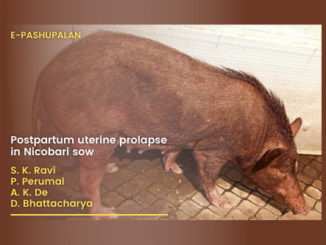

Nice article
Well done
Nice and very informative article…all the best..
Nic information
Good information doctre, continue the good work
Very very useful information
Good information
Super work
Nice one
Very nice information
Nice article
Nice article bro keep doing
Nice article 👌😊😍❤️
Humanity still exists awesome brother keep it up may god bless you you are doing very good for animals awesome very nice article
Very nice article sir
Great article 👍
I like your job Dr. Rahul pawar
Save animals
Nice article sir
Its a very great work for animals
Good job dr rahul nice article
Good work
Good article doctor…Great job! Keep it up
Very good article by Dr pawar
Nice article
Very good and informative article Dr power, good job I think this technique is very useful in field conditions 👍👍👍👍
Valuable opinion
Good Article ..Dr rahul
It’s a good article rahul 👌🏻👌🏻
You are great sir because you are doing for animals
From this info,I bet u make Babies smile!!😅
Very good article sir 👍
Super
Supar Dr Rahul pawar
Informative.
Good one👍
very imp information
Good article sir .good information
Nice article
Indeed an spectacular article by Dr.Rahul.Pawar
It’s very informative….a good one indeed
What an article…shyavagyag majjigi sir..👍👍
Nice artical sir …
Thank you very much! Good work for Field Veterinarians!
Wonderful article.
Super article sir
Nice article good information
Nice article Dr Rahul pawar
Super
Nice
Good one sir , very helpful for us .
Super article
Nice article
It’s very nice article bro….
Osm article
Very good article..
Nice article bro
Nice article
Nice article
Good article ..dr .. keep it up..
Great article sir
This information S good n sufficient rahul pawar… Well done
Nice article bro
Nice article my brother rahul
Nice article bro
Nice information
Nice article
Practical and useful information…
Nice article Dr.pawar
Nice article and very informative
Nice information, good article Dr. Rahul
Nice article sir
Fabulous Rahul ji
nice source of information , good article Dr rahul .
informative article sir
Good..keep it up sir..
Nice work, informative, keep up the good work.
It’s a superb article Mr. Dr Rahul and you did exllent job for the Animals.
The blood transfusion is a very useful in an emergency condition and your article is very useful for the animals and you are spreading a very nice information to the all doctors and peoples.
Well done! Keep it up 👍
Very informative sir .
GOOD VALUABLE ARTICLE
it is very good article and it very helpful information for me sir
This information is actually good, I appreciate author.
Very nice n practical information
Very informative one doc
Nice article almost cent percent aspects have been covered regarding blood transfusion
👍
It is very informative article.
Nice information
Very nice information sir
Good article sir, these information may help many doctors to treat the animals with hematology disorders
It is really good informative and help in field. Tq u sir
Very good article sir….
Super nice article and it’s a helpful to us
Good my dear Dr.Rahul pawar
Nice article sir…. I hope it will make a huge revulsion in field condition… Jai Bidar… Jai KVAFSU..
Usefull article…..and helpfull to
Best information Rahul
Very informative article.
In haemoprotozoan diseases at field level we can first go for Iron dextron inj. And other blood enrichers.
Atlast transfusion can be carried.
Nice Article.
Very useful article keep it up bro
Very useful information for field conditions
Good job
I found it very useful Ty for the detailed info…..
Very nice article brother and yousfull
Informative..
Very helpful
Good information Dr
Nice article 👍
Good one sir
Good article.. Hope it will be a more routine procedure in future.
Best article
Breakthrough in this field….good one doc!!
Informative and helpful in field conditions too
Very nice article 👌
Very informative sir
Nice one
Good article
Wow,superb
It is so good and use full information sir
Good information sir
It is very helful, good article
Nice article sir. Very useful
It’s very nice article sir
Very nice and precise information….
Informative and nicely quoted
Yes! This is wonderful work it helps some lives..
Gud one sir
Nice article sir
Helpful article sir
Very good sir
Informative article 👏👏👏
Nice work, good informative article
Super information sir,it may helpful to many Veterinary Doctors to treat the Diseases. Thanks sir😘😘
Nice and useful information Sir.
Good article!!
Very resourceful
Nice artical sir.
Excellent work
Excellent ideas
It’s usefull information for beginners
Very nice and informative article sir and can be easily understood
Finest article…. concept explained in relevant manner…..good job
Helpfull for needy cases…..
Good article sir helpful
Super and fantastic ,nice it’s a good article
Nice article
Good one,thank you sir
for such great informative article.
Superb Buddy.. good information keep going 👍👍
Nice article doctor.
Informative article sir.
Informative article..
Gud information
Informative
nice Work man.
Awesome article Doctor.
Informative, keep going..
Super
Good work
Nice one
Very helpful information
ಸೂಪರ್ ಸರ್ ಅರ್ಥ ಪೂರ್ಣವಾಗಿ ಮಾಹಿತಿಯನ್ನು ನೀಡಿದ್ದಕೆ ಅಭಿನಂದನೆಗಳು ಸರ್. 👌👌🙏🙏
Very informative article
Good and nice aeticle
Nice article
Very informative sir
It’s nice. Very helpful article. Please publish more articles on this topic.
Good informative article..
Nice Article Good. Keep going on …
All the best
This is really a noble work, better than worshipping god,I wish doctor bright future
Useful article very good content
A very good initiative in a rural area as such and quiet an informative article
Great initiative to field of veterinary large ruminants.. much needed article… Proud to be vet
Information was very much helpful…….good initiative.
Nice information sir
Best article….with good information
Good article
It is very usefull article.. all the best Dr. Rahul Pawar
Good article sir
Good initiative in bovines and cattles…a useful information sir..
Nice one bro…… Keep updating the budding Veterinarians
It will be of great help for LA practitioners.
Very informative.it will be of great help for LA practitioners.
Informative one
Super Doc
Nice article.
Nice article Dr Pawar
Very informative article Rahul sir!!! ✌️
Nice article, very informative!
The application of Blood transfusion techniques to large animals will be a boon to many veterinarians and the information provided by Dr Rahul sir in this article, will no doubt provide a lot of confidence to the field veterinarians.
Thank you so much sir for providing a brief insight towards this technique. Hope to see more articles in the future.
Nice article 👍
Very concise and very informative as well…
Congratulations Dr Rahul pawar for this great work
Nice article pawar sir…
Nice article
Nice article pawar sir…
Good information Dr. Rahul
Nice one Dr.Rahul….keep publishing such useful articles
Informative article
Good information
Good one !!
Nice article by Dr Rahul
Good article from Dr rahul pawar
Very informative article
Nice article, very informative!
Congratulations doctor pawar… Nice work…
It is very helpful article for saving life of every animal
Very informative topic and practically useful sir
Good article
Good article
Very useful article for Veterinary Field.
Nice article doctor rahul
Brilliant information 👌👌
Useful information sir
Nice initiative measure in bovines and keep rocking …
Good article sir 👏
Nice article Sir
Valuable information sir…New idea for field vets
Good article Sir and Informative.
GOOD ARTICLE SIR!!!!
Helpful article about blood transfusion. 👏
Gud article sir
Gud article nd useful information sir
Good article
Informative article. Nice bro. Good one
Good article
Good info, was very helpful to know, thnx
Very informative and it will play a crucial role in treating animals in near future
Good Resourseble article brother
Nice articles
Nice article fantastic
Nice article by My friend
Nice article
Nice article .easy to understand
One of the good source of information and helpfull for all👍
NYC article my friend Dr Rahul pawar
Thank you rahul sir helpful for beginners
Nice article by Dr Rahul oawar
Nice article by dr Rahul Pawar bro
Nice article
Nice article bro good information
Nice article rahul pawar good information
Nice article by my friend Dr rahul pawar
Nice article by my friend
Good information
It’s knowledgable and helpful 4 many people, in saving lives of these dear ones.ur work on it is exceptional appreciable.
Informative article nice attempt..
Very informative
Good article.
Nicely delivered to apply for field
Nic article
Good and informative article
Nice article
Best Article I ever read,with brief knowledge and covered complete and very easy to read and understand about Blood Transfusion
Good article ..nice information for beginners !
Nice article
Rare and useful one.
Nice article sir
Nicely covered all the aspects good article
Tq for the good article and resoursable one sir ….it can help @ field level
Nice article..
Nice and very informative article 👍
Good information
From this article I got brief knowledge about blood transfusion sir , thank you sir
Good article sir
Best article
Good work
Useful information sir…
Helpful article for juniors👍
Very Good article
Nice article it is helpful for beginners
Good article sir 👏👏 useful one 🙌
Good article sir
Helpful article…!
Nice article sir!!!!!!!
Good sir
Good information sir
Good work sir 👏,, very good information
It’s a good article
I have doubt in using of sodium citrate 3.8% solution at the rate of 1ml/10ml of blood. It’s not 100ml per 350ml blood?
And
It’s not advised to use antihistamines and corticosteroid in every case before transfusion. Many case doesn’t show any symptoms of hypersensitivity.
Thank you
Nice information
Very beautifully narrated In a short way
Superb enjoyed reading it
Nice article
Nice article
You are an avenger now, for saving the life of the calf..@ KVAFSU BIDAR
You are an avenger now..@ KVAFSU BIDAR
Good article sirr👌
Informative article
Nice Article
Very good information which is required for everyone of us.
Covered good scientific literature, nice article
Good Article Rahul, this information may help many doctors to treat the animals related with hematological disorders or disease…
Nice good one
Thank you sir ,Good article
very resourceful !
Nice information
Good article
Thank u sir,helpful for beginners